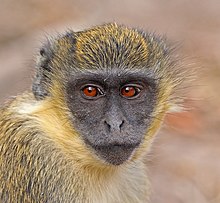Chlorocebus sabaeus
| Green monkey | |
|---|---|
 |
|
| juvenile, Gambia | |
| Scientific classification | |
| Kingdom: | Animalia |
| Phylum: | Chordata |
| Class: | Mammalia |
| Order: | Primates |
| Family: | Cercopithecidae |
| Genus: | Chlorocebus |
| Species: | C. sabaeus |
| Binomial name | |
|
Chlorocebus sabaeus (Linnaeus, 1758) |
|
 |
|
| Geographic range | |
The green monkey (Chlorocebus sabaeus), also known as the sabaeus monkey or the callithrix monkey, is an Old World monkey with golden-green fur and pale hands and feet. The tip of the tail is golden yellow as are the backs of the thighs and cheek whiskers. It does not have a distinguishing band of fur on the brow, like other Chlorocebus species, and males have a pale blue scrotum. Some authorities consider this and all of the members of the genus Chlorocebus to be a single widespread species, Chlorocebus aethiops.
The green monkey is a sexually dimorphic species, with males typically being slightly larger than females. Wild adult males weigh between 3.9 and 8.0 kg (8.6 and 17.6 lb) and measure between 420 and 600 mm (1.38 and 1.97 ft), while the females usually weigh between 3.4 and 5.3 kg (7.5 and 11.7 lb) and measure between 300 and 495 mm (0.984 and 1.624 ft).
female with baby, The Gambia
male, Senegal
young adult, The Gambia
rear of male, Senegal
Callithrix monkeys can be found in a wide range of wooded habitats, ranging from very dry Sahel woodland to the edge of rainforests. It is also commonly seen in coastal regions, where known to feed on seashore foods such as crabs. It also takes a wide variety of other foods, including fruits and invertebrates.
The green monkey is found in West Africa from Senegal to the Volta River. It has been introduced to the Cape Verde islands off north-western Africa, and the West Indian islands of Saint Kitts, Nevis, Saint Martin, and Barbados. It was introduced to the West Indies in the late 17th century when slave trade ships traveled to the Caribbean from West Africa.
...
Wikipedia

